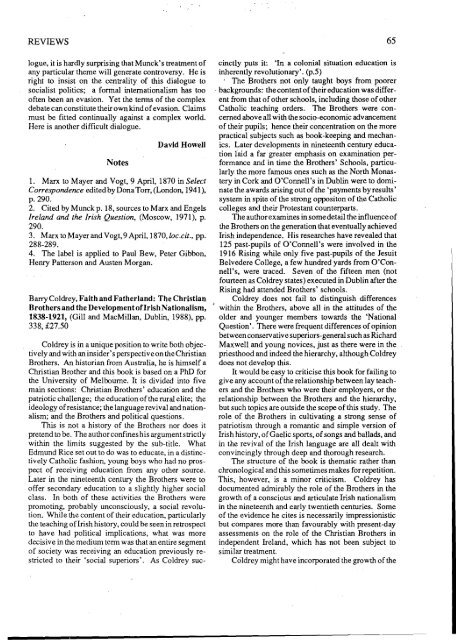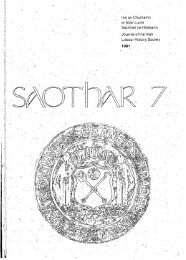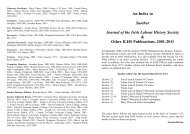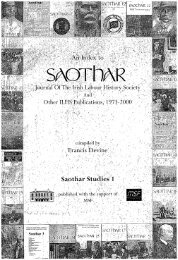Create successful ePaper yourself
Turn your PDF publications into a flip-book with our unique Google optimized e-Paper software.
REVIEWSlogue, it is hardly surprising that Munck's treatment ofany particular theme will generate controversy. He isright to insist on the centrality of this dialogue tosocialist politics; a formal internationalism has toooften been an evasion. Yet the terms of the complexdebate can constitute their own kind of evasion. Claimsmust be fitted continually against a complex world.Here is another difficult dialogue.NotesDavld HoweIl1. Marx to Mayer and Vogt, 9 April, 1870 in SelectCorrespondence edited by DonaTorr, (London, 1941),p.290.2. Cited by Munck p. 18, sources to Marx and EngelsIreland and the Irish Question, (Moscow, 1971), p.290.3. Marx to Mayer and Vogt, 9 April, 1870, loc .cit., pp.288-289.4. The label is applied to Paul Bew, Peter Gibbon,Henry Patterson and Austen Morgan.BarryColdrey, Faith and Fatherland: The ChristianBrothers and the DevelopmentofIrish Nationalism,1838-1921, (Gill and MacMilIan, Dublin, 1988), pp.338, £27.50Coldrey is in a unique position to write 50th objectivelyand with an insider's perspective on the ChristianBrothers. An historian from Australia, he is himself aChristian Brother and this book is based on a PhD forthe University of Melbourne. It is divided into fivemain sections: Christian Brothers' education and thepatriotic challenge; the education of the rural elite; theideology of resistance; the language revival and nationalism;and the Brothers and political questions.This is not a history of the Brothers nor does itpretend to be. The author confines his argument strictlywithin the limits suggested by the sub-title. WhatEdmund Rice set out to do was to educate, in a distinctivelyCatholic fashion, young boys who had no prospectof receiving education from any other source.Later in the nineteenth century the Brothers were tooffer secondary education to a slightly higher socialclass. In both of these activities the Brothers werepromoting, probably unconsciously, a social revolution.While the content of their education, particularlythe teaching of Irish history, could be seen in retrospectto have had political implications, what was moredecisive in the medium term was that an entire segmentof society was receiving an education previously restrictedto their 'social superiors'. As Coldrey suc-cinctly puts it: 'In a colonial situation education isinherently revolutionary'. (p.5), The Brothers not only taught boys from poorer. backgrounds: the content of their education was differentfrom that of other schools, including those of otherCatholic teaching orders. The Brothers were concernedabove all with the socio-economic advancementof their pupils; hence their concentration on the morepractical subjects such as book-keeping and mechanics.Later developments in nineteenth century educationlaid a far greater emphasis on examination performanceand in time the Brothers' Schools, particularlythe more famous ones such as the North Monasteryin Cork and O'Connell's in Dublin were to dominatethe awards arising out of the 'payments by results'system in spite of the strong oppositon of the Catholiccolleges and their Protestant counterparts.The author examines in some detail the influence ofthe Brothers on the generation that eventually achievedIrish independence. His researches have revealed that125 past-pupils of O'Connell's were involved in the1916 Rising while only five past-pupils of the JesuitBelvedere College, a few hundred yards from O'Connell's,were traced. Seven of the fifteen men (notfourteen as Coldrey states) executed in Dublin after theRising had attended Brothers' schools.Coldrey does not fail to distinguish differenceswithin the Brothers, above all in the attitudes of theolder and younger members towards the 'NationalQuestion'. There were frequent differences of opinionbetween conserv ativ e superiors-general such as RichardMaxwell and young novices, just as there were in thepriesthood and indeed the hierarchy, althoughColdreydoes not develop this.It would be easy to criticise this book for failing togive any account of the relationship between lay teachersand the Brothers who were their employers, or therelationship between the Brothers and the hierarchy,but such topics are outside the scope of this study. Therole of the Brothers in cultivating a strong sense ofpatriotism through a romantic and simple version ofIrish history, of Gaelic sports, of songs and ballads, andin the revival of the Irish language are all dealt withconvincingly through deep and thorough research.The structure of the book is thematic rather thanchronological and this sometimes makes forrepetition.This, however, is a minor criticism. Coldrey hasdocumented admirably the role of the Brothers in thegrowth of a conscious and articulate Irish nationalismin the nineteenth and early twentieth centuries. Someof the evidence he cites is necessarily impressionisticbut compares more than favourably with present-dayassessments on the role of the Christian Brothers inindependent Ireland, which has not been subject tosimilar treatment.Coldrey might have incorporated the growth of the65





